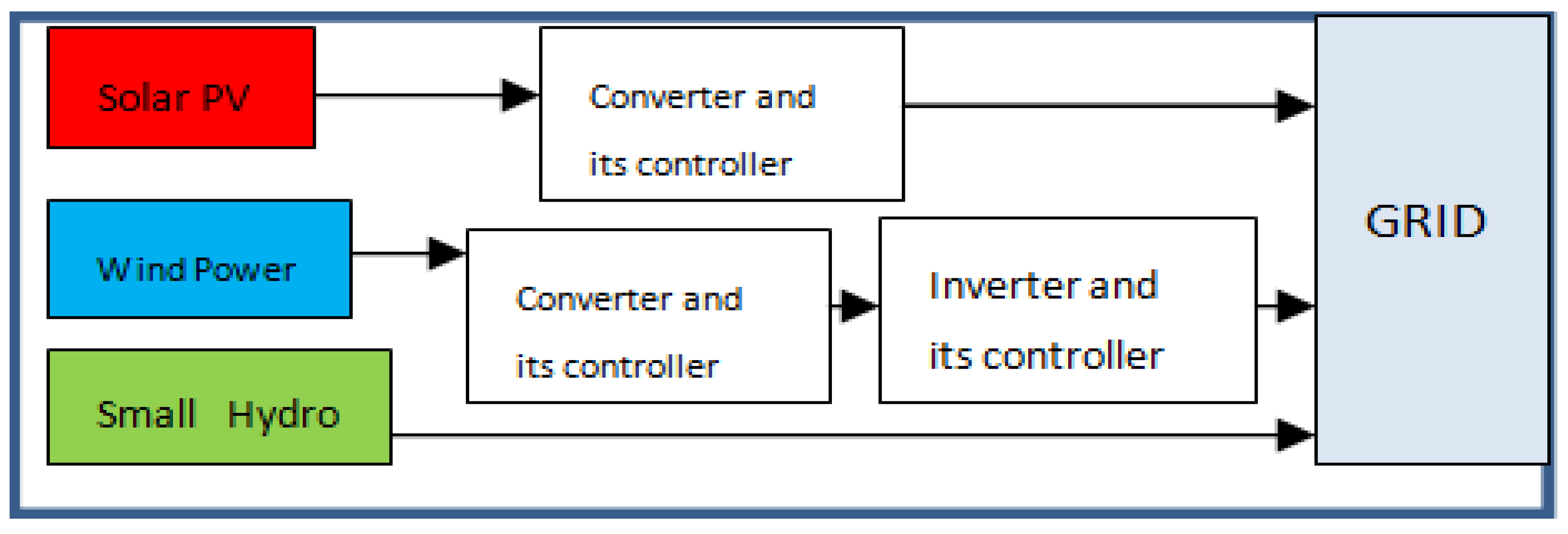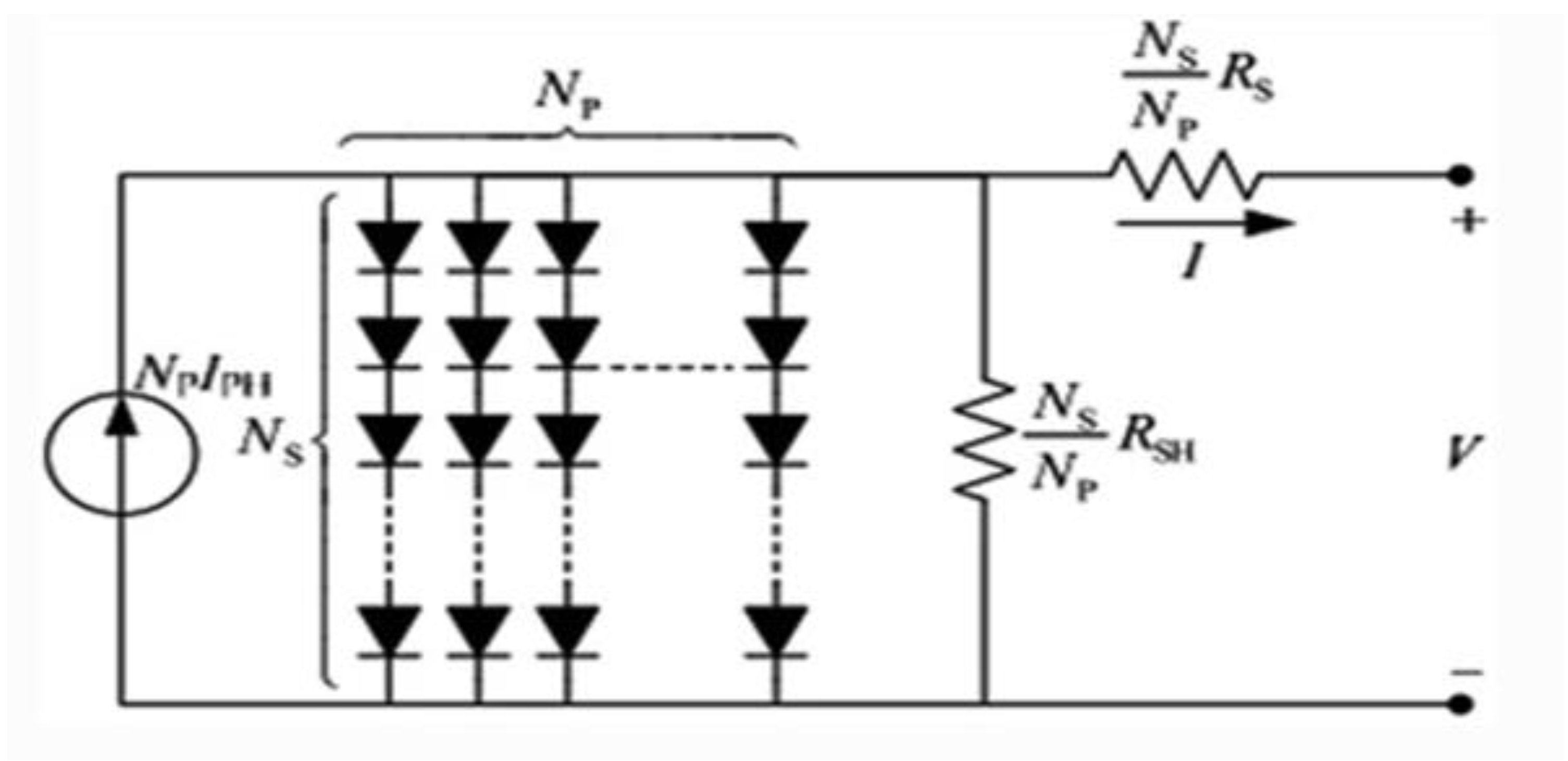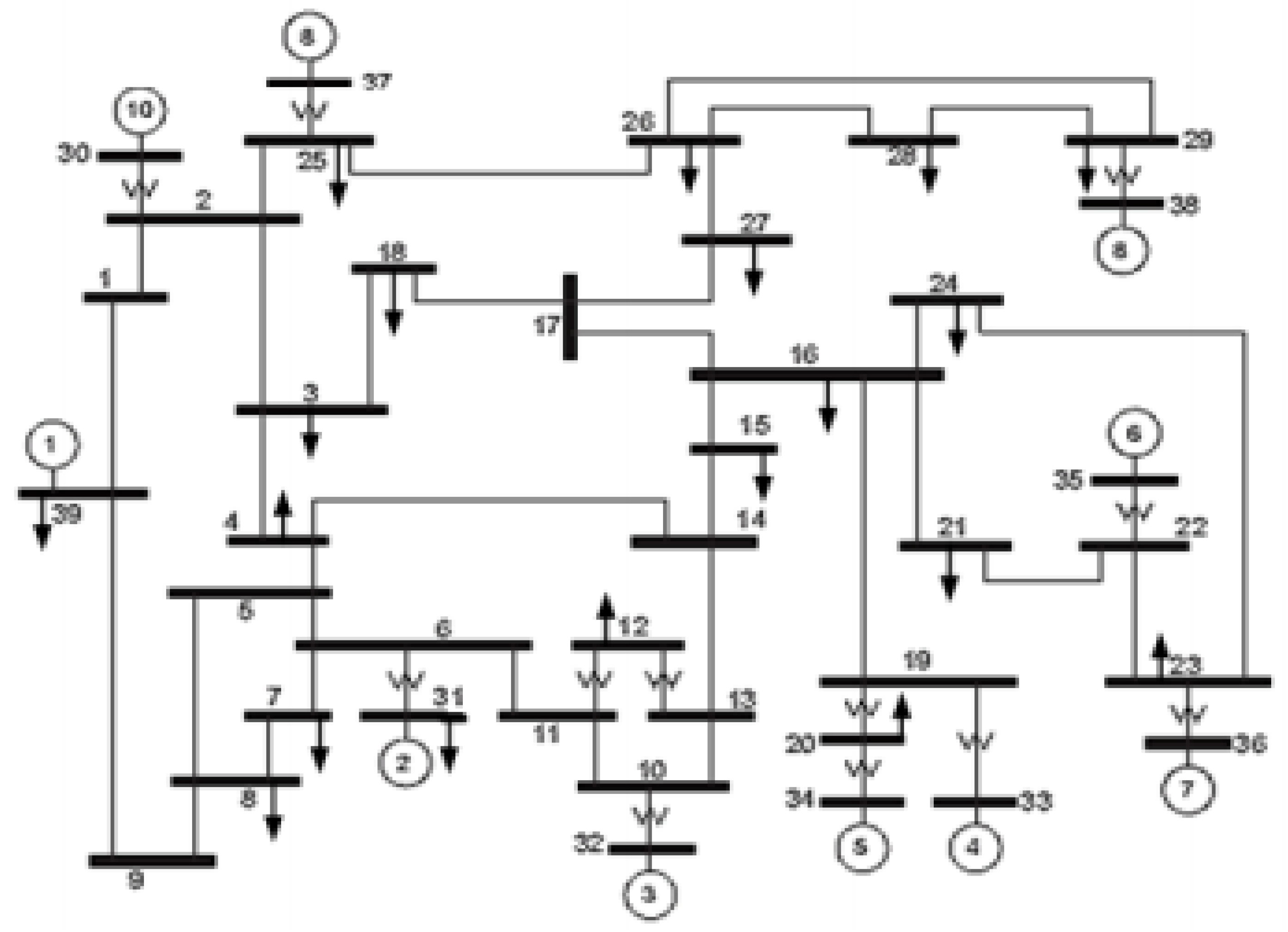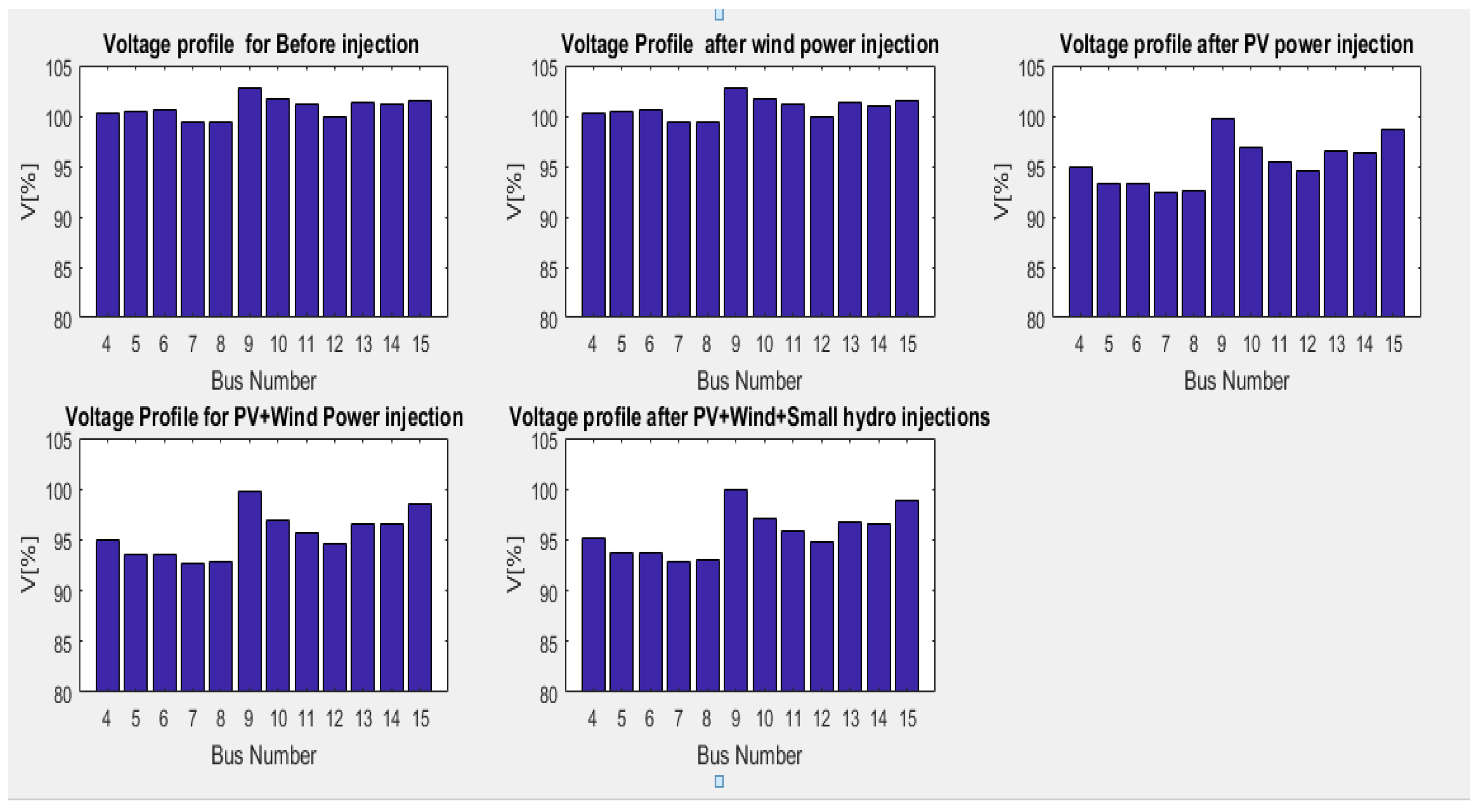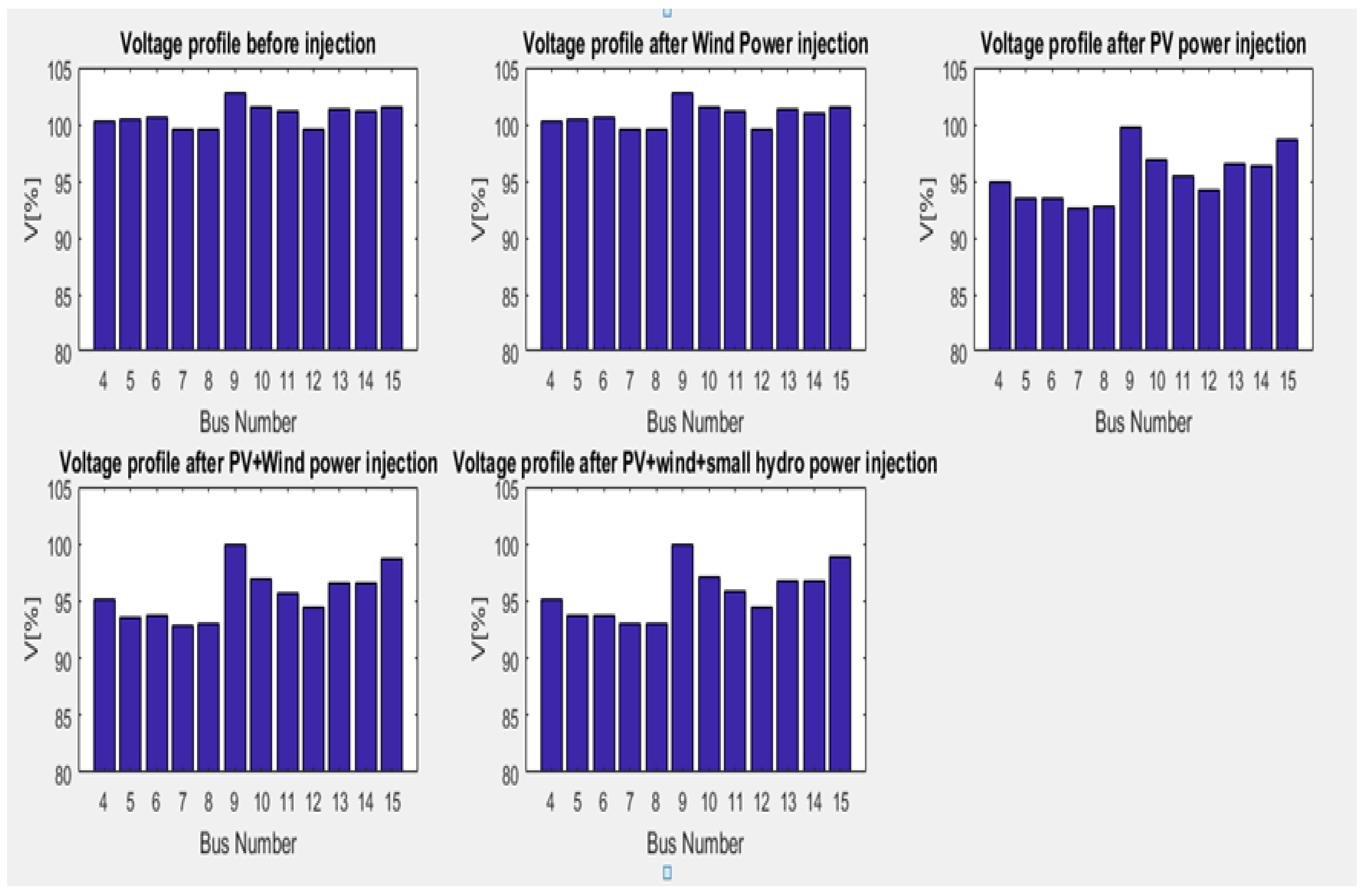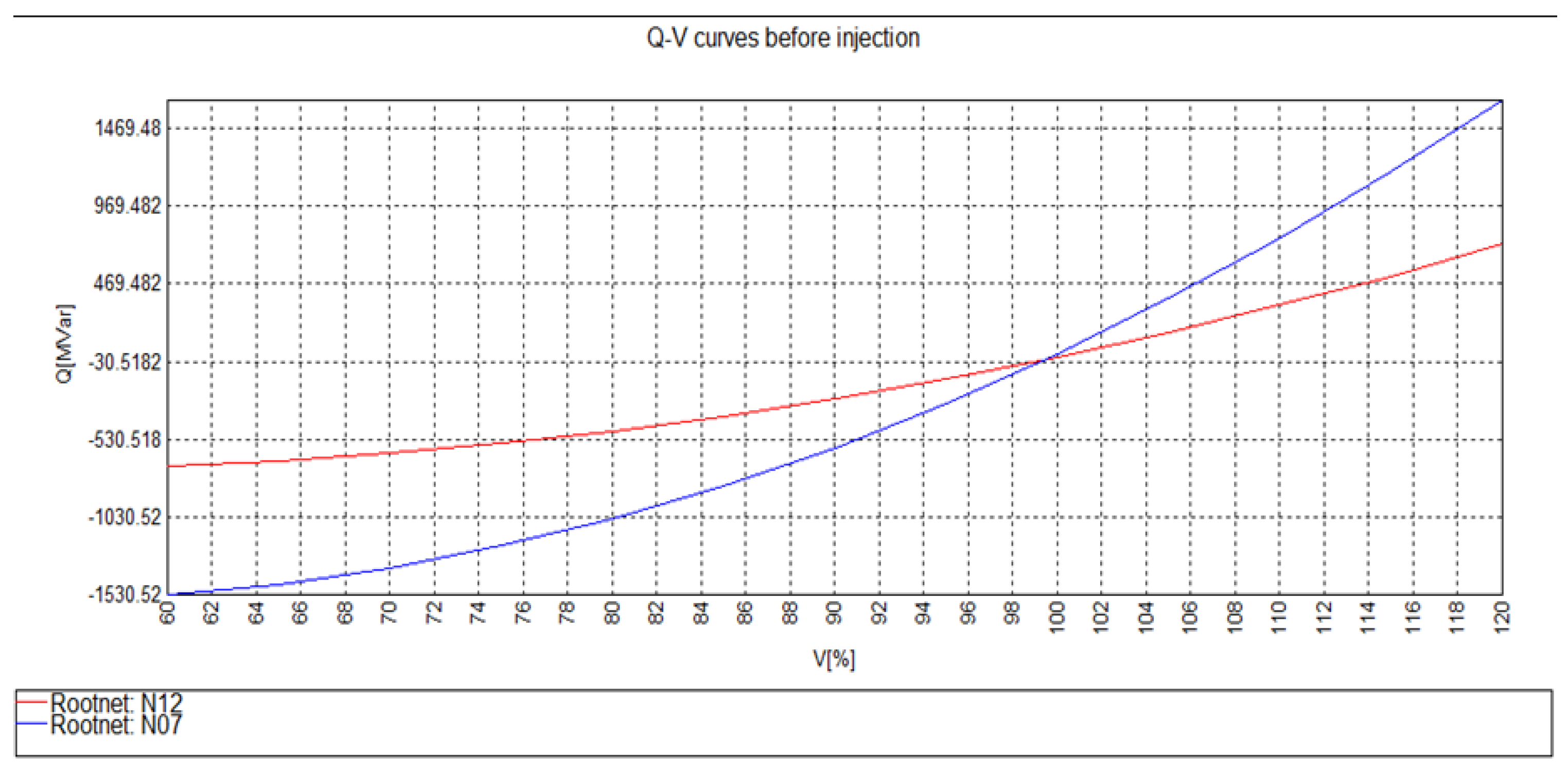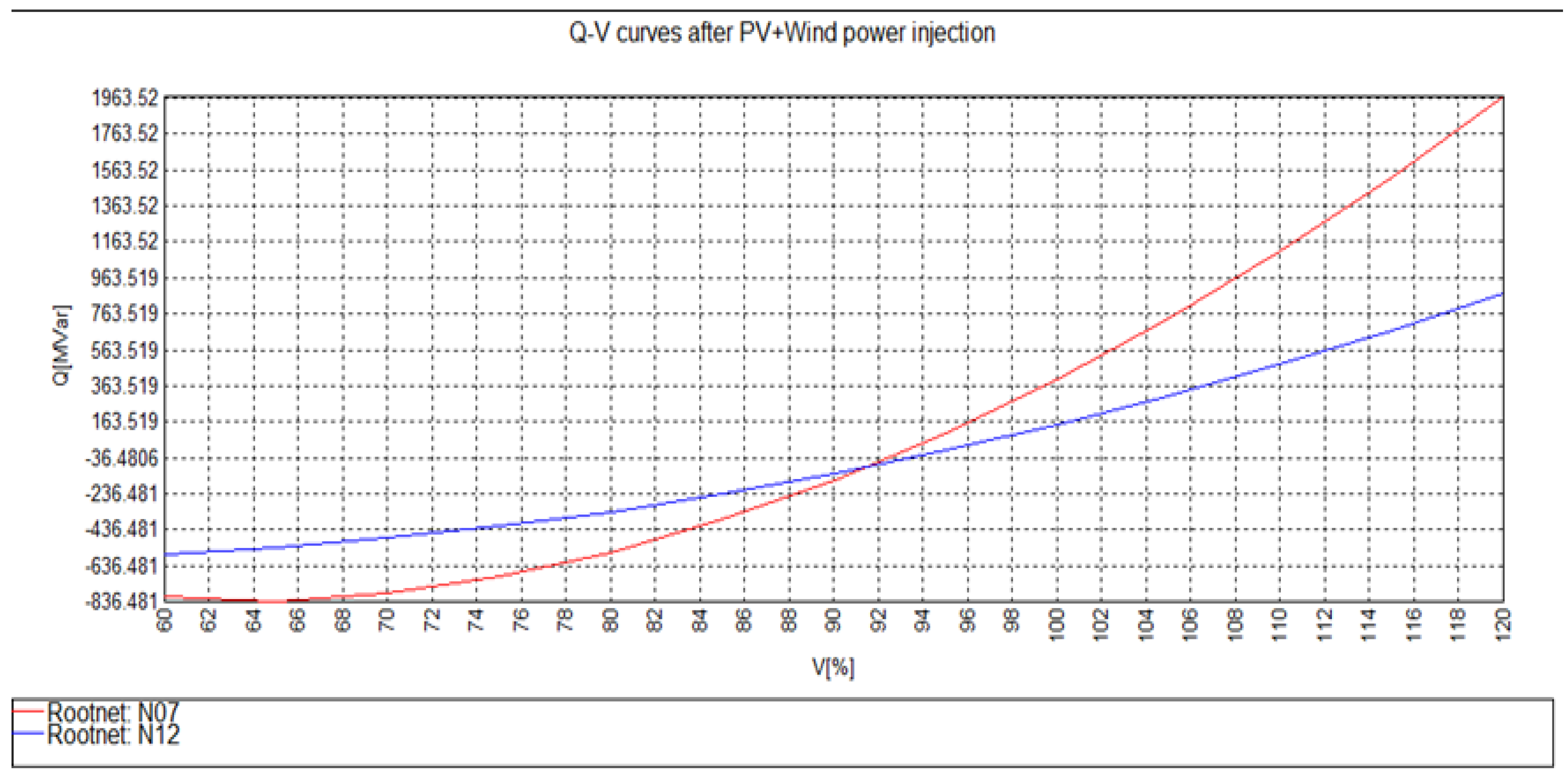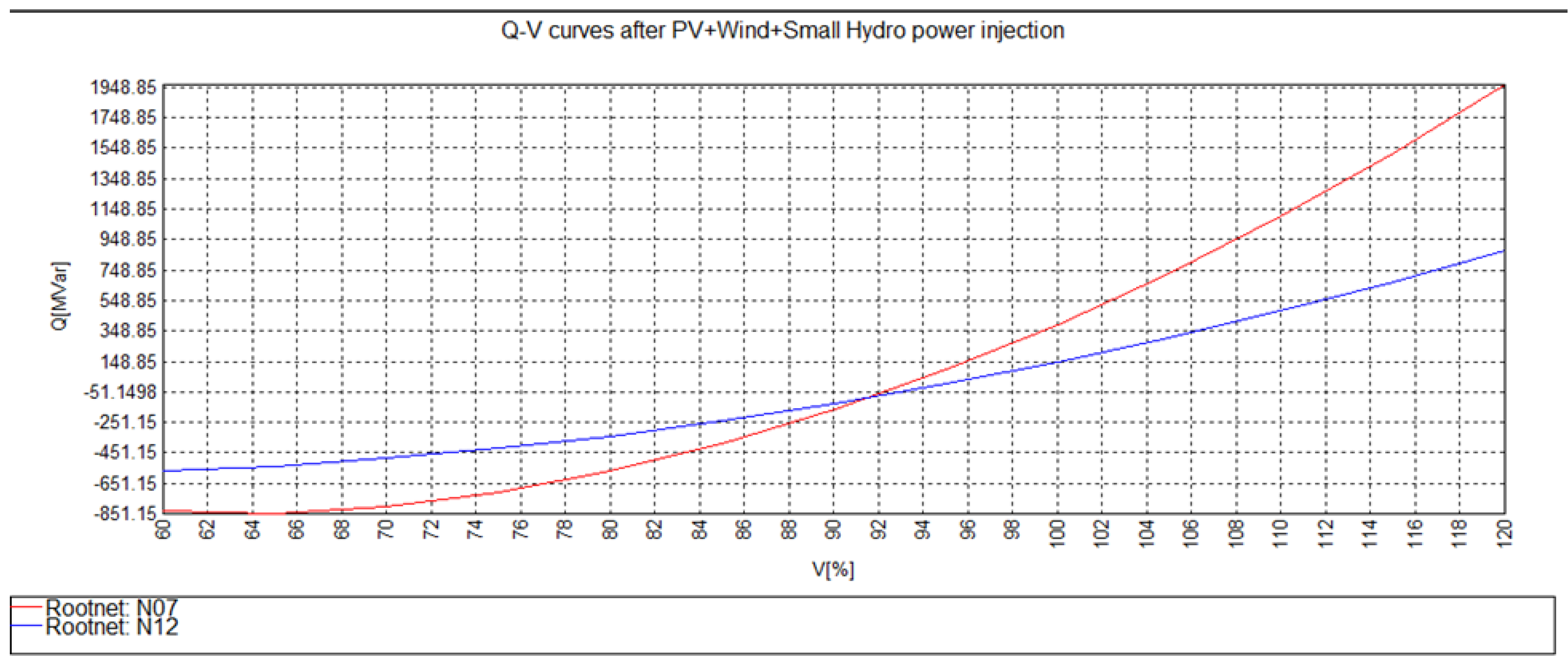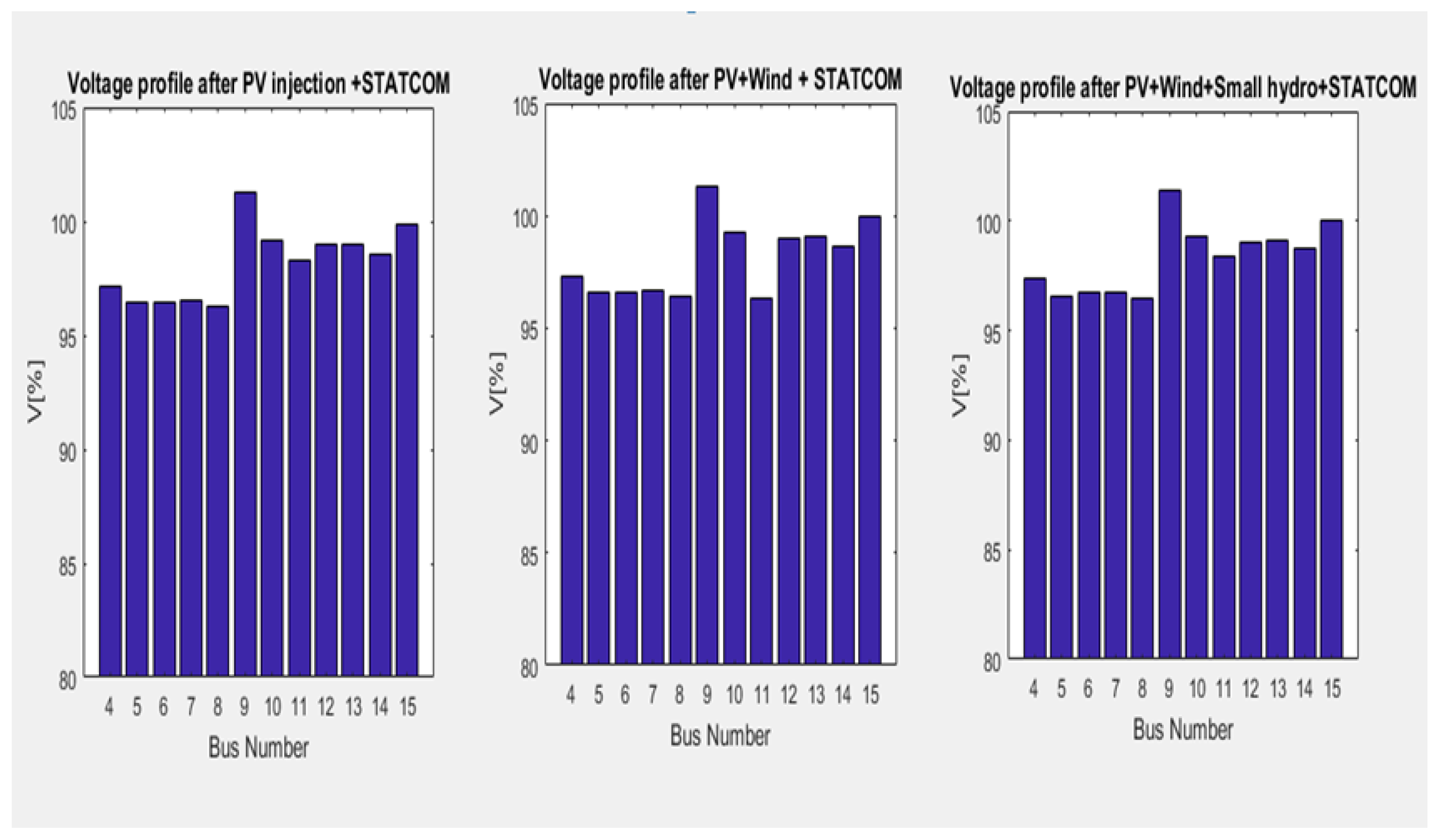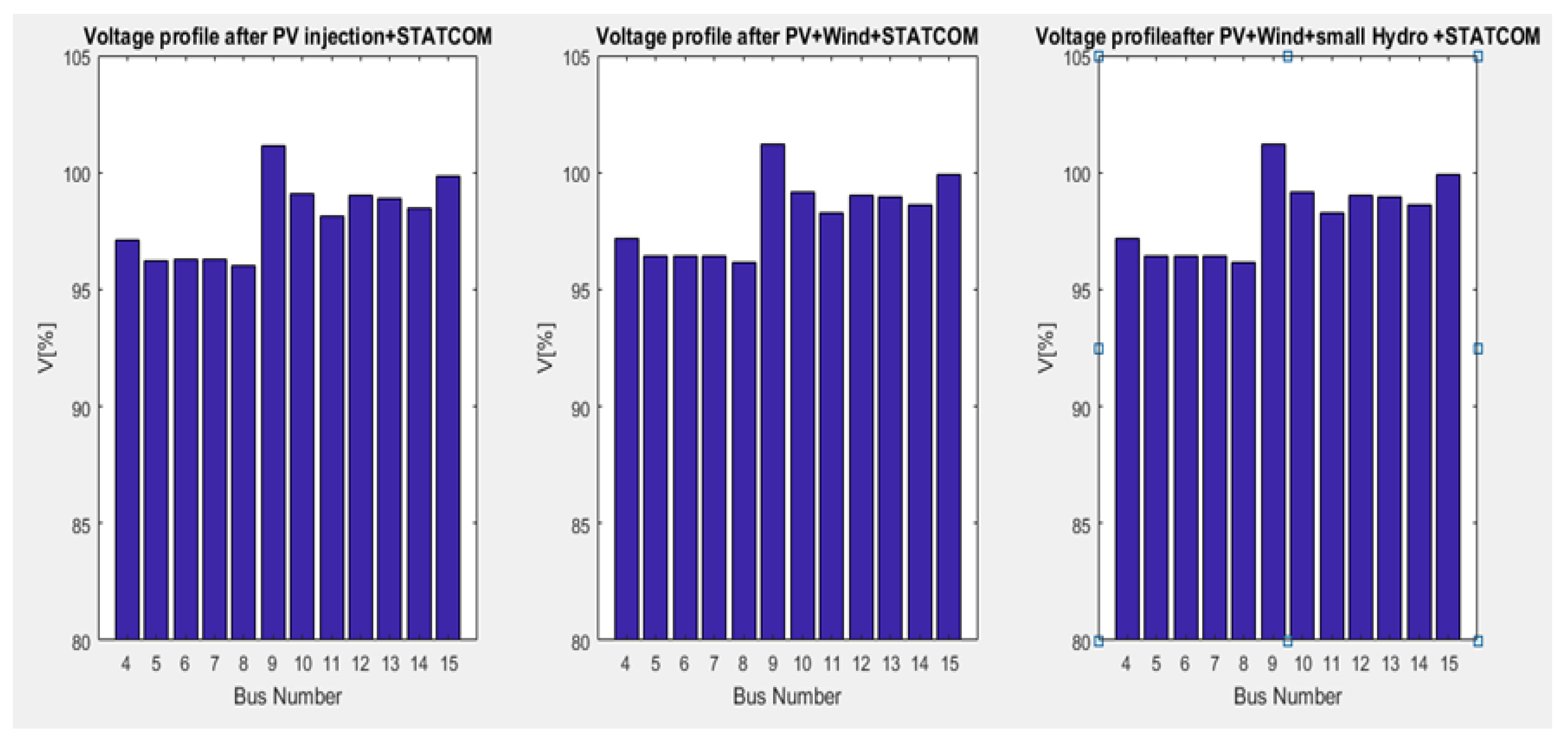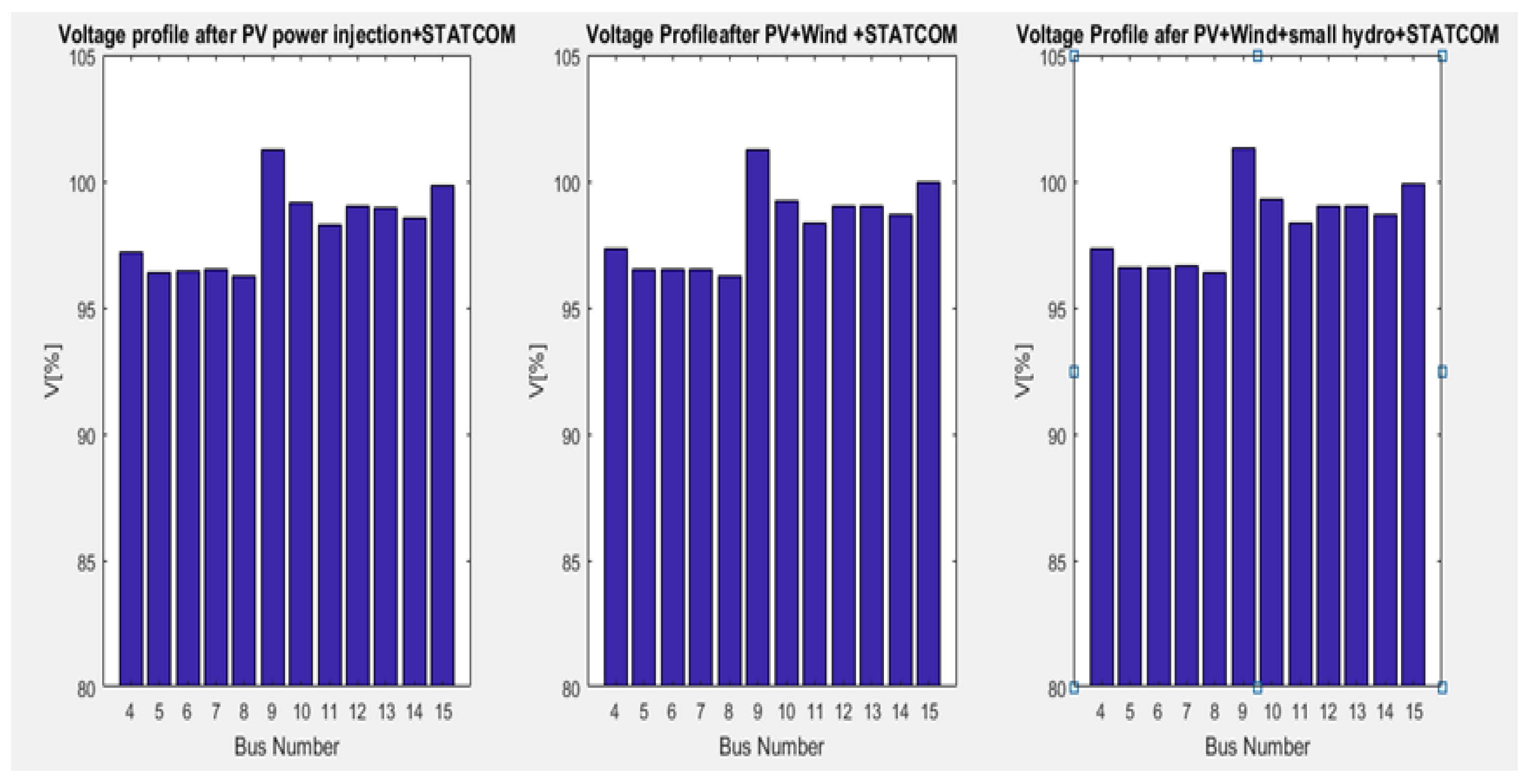1. Introduction
The demand for electric energy is rapidly increasing and putting pressure on utilities to expand their generation. This coupled with the need for clean energy has led to energy demand growth. Because of this, the researchers are envisaging the power generation technique from the renewable energy sources such as solar, hydro and wind. These energy sources are preferred for distributed generation because of their abundance, cleanliness and low cost [
1,
2]
Solar PV and Wind power systems are getting popular because of their availability and reducing cost. However, they are intermittent in nature [
3,
4,
5,
6] and cannot satisfy power requirements alone throughout the year. Small hydro systems are also getting interest to generate electrical power in remote areas. The limitation to small hydro power is its poor voltage and frequency regulation. Therefore, a reliable technique is required to maintain constant voltage and frequency irrespective of the load and load types [
7].
Grid interconnection of these renewable energy sources come with many advantages such as [
8,
9,
10]:
Less environmental pollution because of increased use of non- polluting generation sources.
Low cost because of non- consumption of fuel.
The power capacity of connected grids increase to meet the increase in demand.
Improved supply security.
Cheaper power for consumers due to increase in power supply from cheaper sources.
Photovoltaic (PV) can generate electricity from readily available sunlight [
11]. This power can either be utilized in stand-alone mode of connected to the grid. Significant increase in PV generation connected to the grid present technical challenges and major impacts on system stability due to its stochastic nature [
12]. Literature [
13] analyzes voltage stability of a power system using P-V curves. In [
12,
14] the effects of photovoltaic integration at different levels is analyzed. Literature [
15] discusses the effects of high penetration of PV power on voltage stability of a network. It also analyzes the effects on voltage levels when the connected PV power is lost due to shading of PV panels by movement of clouds. It also proposes the use of D-STATCOM to compensate for instability.
There is a high growth of wind power generation which is estimated to reach 20% of the total generation by the year 2040 [
16,
17]. The mostly used generator in wind farms is the doubly fed induction generators [
18]. Due to the intermittency of wind power and the reactive power consumption of DFIG, the effects of integration of wind farms into the grid cannot be neglected [
19,
20]. Integration of small amounts of wind power while maintaining the conventional sources can help in voltage support as found in [
21]. Serious problems on voltage stability and power quality arise due to wind farm integration with the grid on large scales [
22].
The majority of power used worldwide is from hydro power plants; up to 20% of the total power [
8,
23]. However this power comes from large hydro power plants that require huge amounts of land for water reservoirs and dams and usually cause environmental effects. This has led to increased research on small hydro power plants that operate on run-off rivers which do not require any reservoirs [
24,
25]. Small hydro power plants can handle peak load demand easily with less cost compared to their conventional generating plants due to the slow start-up and operational needs of the latter [
26,
27]. The increase in grid interconnection of micro-hydro power plants in the recent past is due to their excellent performance and benefits such as high efficiencies (70–90%), high capacity factors (greater than 50%) and low output power variations [
8,
28,
29,
30].
Voltage stability is one of the main challenges that come up with grid interconnection of intermittent renewable energy sources. Voltage stability can be divided into static or dynamic. Dynamic voltage stability is based on differential equations that determine the variation of bus voltages with varying system operating parameters. The methods used in analyzing the dynamic voltage stability include bifurcation analysis, small signal stability analysis, time domain simulations and energy function method [
31,
32,
33,
34]. Static voltage stability is based on power flow equations and can point out the mechanisms of voltage collapse for different operating conditions. This method takes less computational time and yields most of the required information concerning voltage stability of the system [
35]. Since the system dynamics that influence voltage stability are slow, many aspects can be analyzed by use of static methods which determine the viability of equilibrium point represented by a given operation of the power system [
36]. The methods used in static voltage analysis include; Q-V curves, bus sensitivities and P-V curves [
35].
Due to the effects on power quality arising from connection of these renewable energy sources to the grid, several mitigation methods have been used in literature. Flexible AC transmission systems (FACTS) have been used to improve voltage profile in grids affected by connection of renewable energy sources. FACTS refers to a family of power electronic devices that can control the flow of active and reactive powers [
37,
38]. These FACTS devices can either provide series compensation or shunt compensation. Series compensation devices include Thyristor controlled series capacitor (TCSC), Thyristor controlled phase shift transformer (TCPST) and static synchronous series compensator (SSSC) [
39] while the commonly used shunt compensators include fixed or variable capacitors [
39,
40] static compensators (STATCOMs) and static VAR compensators (SVCs). Literatures [
41,
42] review the use of dynamic voltage restorer (DVR) and STATCOMs in compensating voltage swells and sags. The combination of the DVR and STATCOM forms unified power quality compensator (UPQC) where DVR is used to supply series voltage in the event of voltage sag or swell while STATCOM is used to supply or absorb reactive power to maintain constant DC-link voltage.
Distribution FACTS devices are popularly used nowadays because they are smaller and less expensive than conventional FACTS devices [
43,
44]. STATCOM devices were used by [
4,
45] to support reactive power demand and improve voltage profile for a wind integrated grid. The performance of FACTS devices is done in literature [
41]. Literature [
42] compares the performance of STATCOM and SVC in improvement of the voltage profile after wind power integration. STATCOM is concluded to give better performance than SVC.
This paper analyzes the effects of connecting three renewable energy sources (solar PV, Wind and micro hydro) to the grid voltage levels. The sensitivities of the grid buses are also analyzed. A method for mitigating these effects is implemented and conclusions made. Solar PV system was connected to the grid through voltage source inverter to convert the DC power to AC power. Wind power was connected to the grid through voltage source converters, one to convert wind power from AC to DC for ease of control mechanisms and the other from DC to AC because the grid used was AC. Small hydro system was connected directly to the grid system.
Due to the effects of these renewable energy sources on the grid voltages and bus sensitivities, distribution static compensator (D-STATCOM) devices were connected to the affected grid buses in order to ensure the voltage levels are within the required standards as stated in IEEE standards. According to this standard, the voltage levels should always be within 5% above or below the nominal voltage value [
46].
Figure 1 show the three renewable energy sources connected to the grid.
3. Simulation and Results
After modeling the three renewable energy sources (Solar PV, wind and small hydro) their powers were injected into the IEEE 39 bus system for analysis of voltage profile, V-Q sensitivities and Q-V curves. Firstly, wind power was injected at bus 12 (15 MW) and bus 28 (15 MW) and analysis done. Secondly, three generators of the test system were replaced by solar power with varying insolation (from 1 kW/m2 to 0.7 kW/m2) at bus 30 (80 MW), at bus 32 (60 MW) and at bus 38 (100 MW) and analysis done. Thirdly, analysis was done with penetration of both wind power and solar power. Lastly, a small hydropower (10 MW) was injected at bus 03 and analysis done when the system is penetrated by all the three; solar power, wind power and small hydro power.
In order to improve the voltage levels to the required standards, the modeled D-STATCOM was connected to buses 12 and 07 and the results analyzed in comparison with those before compensation.
The IEEE 39 bus test system used in this work is shown in
Figure 8.
3.1. Weak Buses of the IEEE 39 Bus System
The weakest buses of the IEEE 39 test bus system were determined using bus participation factors and are shown in
Figure 9. The weakest buses are buses 12, 07 and 08.
3.2. Voltage Profile
3.2.1. Voltage Profile before Varying Reactive Power
Table 4 and
Figure 10 (considering the weak buses of the system) show the voltage profile of the IEEE 39 bus system before injecting any of the modeled systems into it, when wind power is injected at buses 12 and 28, when solar PV power alone is injected into buses 30, 32 and 38, when both solar power(injected at buses 30, 32 and 38) and wind power (injected at buses 12 and 28) and when all the three are injected to the grid; (solar power at buses 30, 32 and 38, Wind power (at buses 12 and 28) and small hydro power (at bus 03). Both Voltage levels and percentage of the nominal voltages are shown in
Table 4 while the percentage voltage levels for the weakest buses of the system are depicted in
Figure 10.
From the
Table 4 and
Figure 10, the voltage profile for the weak buses are seen to reduce when the system is penetrated with PV solar power then slightly improve with the connection of wind power and small hydro power into the system. The buses with the highest voltage drops when PV power is used to replace the three IEEE 39 bus test system were, bus 5 from 100.53% to 93.54%, bus 6 from 100.77% to 93.57%, bus 7 from 99.7% to 92.77% and bus 8 from 99.6% to 92.89%. Considering the weakest buses of the system (12 and 07) the voltage levels percentages for bus 12 are seen to change from 100.02% to 99.96% to 94.67% to 94.84% and 94.95% in the presented order while for Bus 07, the voltage profile percentages change from 99.7%, to 99.7% to 92.77% to 92.99% to 93.93% in that order.
3.2.2. Voltage Profile When Reactive Power on Bus 07 Is Varied
The reactive power consumed by the load on bus 07 was varied and voltage profile analyzed.
Table 5 and
Figure 11, show the voltage profile for the system when the reactive power of the load at bus 07 is increased from 84.0 MVAR to 100.0 MVAR.
3.2.3. Voltage Profile When Reactive Power on Bus 12 Is Varied
The reactive power consumed by the load on bus 07 was varied and voltage profile analyzed.
Table 6 shows the voltage profile for the system when the reactive power of the load at bus 07 is increased from 84.0 MVAR to 100.0 MVAR.
Figure 12 shows the voltage profile for the weakest buses of the IEEE 39 bus system.
From
Table 5 and
Table 6 and
Figure 11 and
Figure 12, there is a reduction in the voltage levels when PV penetrates the grid and the voltage levels improve as wind and small hydro powers are injected to the grid. From
Table 5, The buses with the highest voltage drops when PV power is used to replace the three IEEE 39 bus test system were, bus 4 from 100.28% to 94.88%, bus 5 from 100.37% to 93.32%, bus 6 from 100.61% to 93.35%, bus 7 from 99.46% to 92.46% and bus 8 from 99.4% to 92.62%. From
Table 6, the buses with the highest voltage drops when PV power is used to replace the three IEEE 39 bus test system were, bus 4 from 100.31 to 94.91, bus 5 from 100.45% to 93.43%, bus 6 from 100.68% to 93.45%, bus 7 from 99.62% to 92.66% and bus 8 from 99.52% to 92.68% and bus 12 99.62% to 94.22%. Considering buses 04 and 05, from
Table 5; the voltage levels changed 100.28% to100.26% to 94.86% to 95.04% to 95.16% for bus 04 and from 100.37% to 100.37% to 93.32% to 93.55% to 93.69% for bus 05 respectively. From
Table 6 the voltage levels changed from 100.31% to 100.29% to 94.91% to 95.09% to 95.21% for Bus 04 and from 100.45% to 100.44% to 93.43% to 93.65% to 93.78% for bus 05 respectively.
3.3. Q-V Sensitivity Analysis
3.3.1. Q-V Sensitivities before Varying Reactive Power
The bus sensitivities were determined using the standard loads of the IEEE 39 bus system and the results are shown in
Table 7.
From
Table 7, Q-V sensitivities increase with PV replacement of the conventional sources then start reducing as wind power and small hydro power are connected to the grid. Considering buses 12 and 07; the sensitivities change from 0.0332 to 0.0333 to 0.0369 to 0.0367 to 0.0366 for bus 12 and from 0.0150 to 0.10149 to 0.0191 to 0.0189 to 0.0188 for bus 07 respectively.
3.3.2. Q-V Sensitivities when Reactive Power at Buses 07 Is Varied
The reactive power consumed by the load on bus 07 was varied and bus sensitivities determined.
Table 8 shows the bus sensitivities for the system when the reactive power of the load at bus 07 is increased from 84.0 MVAR to 100.0 MVAR.
3.3.3. Q-V Sensitivities when Reactive Power at Buses 12 Is Varied
The reactive power consumed by the load on bus 12 was varied and sensitivities of the buses determined.
Table 9 shows the bus sensitivities for the system when the reactive power of the load at bus 12 is increased from 88.0 MVAR to 100.0 MVAR.
From
Table 8 and
Table 9 the V-Q sensitivities increase when the reactive power is increased compared to those on
Table 4. The V-Q sensitivities are highest when PV alone is injected to the grid but reduce with wind and solar penetration. From
Table 5, the highest sensitivities change from 0.0332 to 0.0333 to 0.0370 to 0.0368 to 0.0367. From
Table 6, the highest sensitivities change from 0.0335 to 0.0336 to 0.0372 to 0.0371 to 0.0370 in that order.
3.4. Q-V Curves
The Q-V curves for the system with standard IEEE 39 parameters, with wind power injection alone, with PV power injection alone, with PV and wind power injection and with PV, wind and small hydro power injections are shown in
Figure 13,
Figure 14,
Figure 15,
Figure 16 and
Figure 17 respectively
From
Figure 13,
Figure 14,
Figure 15,
Figure 16 and
Figure 17, considering bus 07, it is noted that the reactive power margins for the system increased with Wind power injection alone from 1530 MVar to 1531 MVar, reduced with PV injection alone (from 1530 MVar to 800 MVar) then increased to 836 MVar for PV + Wind and to 851 MVar PV + Wind + small hydro for bus 07.
3.5. Voltage Profile after Connecting D-STATCOM
3.5.1. Before Varying Reactive Power
Table 10 and
Figure 18 show the voltage profile after connecting STATCOM on buses 07 and 12 in order to improve the voltage levels before varying reactive power.
3.5.2. After Varying the Reactive Power on the Load at Bus 07
Figure 19 and
Table 11 show the voltage profile of the IEEE 39 bus system when the reactive power of the load at bus 07 is changed from 84 MVar to 100 MVar.
3.5.3. After Varying the Reactive Power on the Load at Bus 12
Table 12 and
Figure 20 show the voltage profile of the IEEE 39 bus system when the reactive power of the load at bus 12 is changed from 88 MVar to 100 MVar.
From
Table 10,
Table 11 and
Table 12 and
Figure 18,
Figure 19 and
Figure 20, it can be seen that after connection of D-STATCOM at buses 07 and 12, all the voltage levels of all the buses were in the required standard i.e., within 5% above or below the nominal value for all the three cases; with PV penetration alone, with PV and Wind power penetration and with PV, wind power and small hydro penetration.
